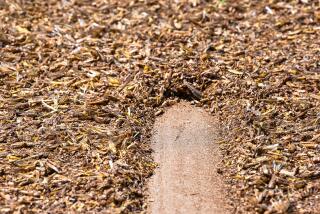International Effort Curbs Africa Locust Threat
- Share via
NAIROBI, Kenya — A $23-million war against an infestation of grasshoppers in West Africa has been won, saving 90% of the crops there, and the threat of catastrophic locust invasions in eastern and central Africa has disappeared, the U.N. Food and Agriculture Organization reported Friday.
“Africans and the international community can be proud of a job well done in the Sahel and eastern Africa, where major food losses have been averted,” Edouard Saouma, director general of the FAO, said in a statement made public in Rome.
Three species of locusts--which are large grasshoppers--had threatened eastern and central Africa this year. Heavy infestations of red locusts, desert locusts and African migratory locusts last year created the potential for a major plague, but preventive spraying and monitoring, as well as generally unfavorable breeding conditions, kept their numbers low.
Problem in Botswana
The only remaining insect problem on the continent is in Botswana, in southern Africa, where farmers are bracing for the second year of a brown locust plague that also threatens Angola, Lesotho, Namibia, Mozambique, Zimbabwe and Swaziland, the report said. Crop damage in Botswana has been prevented so far by early control programs, it added.
In Senegal and neighboring countries in the Sahel, a region of north-central Africa characterized by periodic drought, the grasshopper infestation was the worst in half a century. Most experts said the outbreak was triggered by the very rains that brought relief to the region after several years of drought.
Two dozen U.S. entomologists, pilots and other insect-fighting specialists spent more than a month in Senegal, locating the problem areas and carrying out the largest spraying operation ever attempted in sub-Saharan Africa. The project cost the U.S. Agency for International Development more than $2 million in Senegal alone.
One Plane Crashed
Four DC-7 aircraft, used for insect control in the Western United States, sprayed nearly 1 million acres with malathion one week in September. As a second phase of the operation began earlier this month, one of the four planes crashed in the ocean, killing three of its four American crewmen. The remaining three aircraft resumed the operation several days later, spraying about 1 million acres in Senegal, Gambia, Mali and Mauritania.
A few weeks ago, fields in north-central Senegal had concentrations of grasshoppers ranging from 100 to 1,000 per square yard, but the second phase of America’s widespread spraying and additional localized spraying by Canada, France and other countries killed most of the grasshoppers before they matured and laid eggs.
The Sahel, site of locust plagues throughout history, may have as much as 220,000 tons more food available this year thanks to the grasshopper control efforts, the FAO said. Nearly 4 million acres were treated throughout the region.
Director General Saouma had issued an urgent appeal in July to donors worldwide to contribute to protect this year’s harvest from the swarming insects, which have in the past wiped out hundreds of thousands of acres of food crops in African countries.
The FAO set up an emergency center for locust operations in Rome to coordinate the effort, and 15 countries contributed more than $35 million worth of pesticides, aircraft and support staff to the project, which operated in 13 African countries.
“We waged war on the farmers’ oldest enemy, and we won,” Saouma said. “Like a war, it was fought on many fronts with a cadre of infantry, intelligence and weaponry.”
More to Read
Sign up for Essential California
The most important California stories and recommendations in your inbox every morning.
You may occasionally receive promotional content from the Los Angeles Times.














